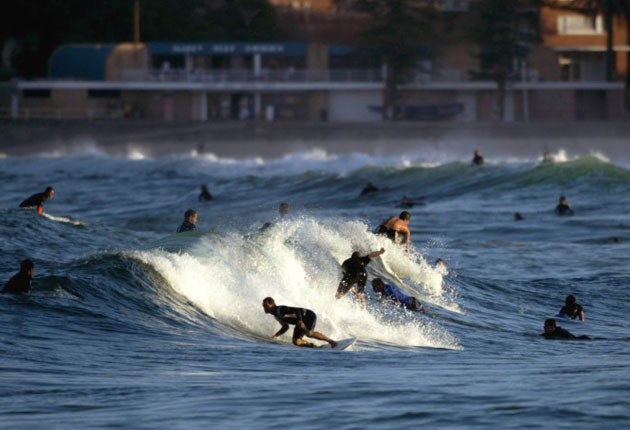Strife on the ocean waves as surf rage grips Australia
Sydney beach forced to display etiquette of the sea as novice board-riders anger locals

Your support helps us to tell the story
From reproductive rights to climate change to Big Tech, The Independent is on the ground when the story is developing. Whether it's investigating the financials of Elon Musk's pro-Trump PAC or producing our latest documentary, 'The A Word', which shines a light on the American women fighting for reproductive rights, we know how important it is to parse out the facts from the messaging.
At such a critical moment in US history, we need reporters on the ground. Your donation allows us to keep sending journalists to speak to both sides of the story.
The Independent is trusted by Americans across the entire political spectrum. And unlike many other quality news outlets, we choose not to lock Americans out of our reporting and analysis with paywalls. We believe quality journalism should be available to everyone, paid for by those who can afford it.
Your support makes all the difference.A statue of Duke Kahanamoku overlooks Freshwater Beach, in Sydney, where the legendary Hawaiian surfer demonstrated his sport to Australians in 1914. Surfing quickly caught on, and has been popular ever since – but now Sydney's many aficionados are being accused of an attitude problem.
At Manly Beach, a stone's throw from the Kahanamoku statue, the waves are now so crowded that the council has been forced to put up signs outlining the correct etiquette for surfers.
Manly, one of Australia's most popular beaches and a major tourist destination, has experienced numerous episodes of "surf rage" in recent times. Locals resent newcomers invading their territory, while novices are considered an unwelcome hazard. A surf school has boosted the number of beginners in the waves.
The signs, aimed mainly at visitors and learners, are the first to be erected by a Sydney council. They advise surfers to avoid such crimes as "dropping in" (ignoring another's right of way to cramp their use of a wave by surfing it yourself) or "snaking a wave" (queue-jumping by swimming around another surfer). They also note the importance of waiting politely, and of informing fellow surfers whether you intend to go left or right.
Manly council says the instructions may be helpful to those ignorant of such rules. But the president of the local surfers' action group, Neil Ohlback, welcomed them. "Instead of signs it could have been muscle," he told the Sydney Morning Herald. "Some of the guys were saying: 'If it doesn't improve, we're going to have to do something about it ourselves.' There was definitely tension with the surf school. This way, if someone paddles up the inside instead of going around, you can point them in the direction of the rules."
Henry Wong, Manly's general manager, defended the signs, saying the public expected the council to regulate behaviour. But some locals have criticised them as a manifestation of the encroaching Australian "nanny state".
At Bondi, Sydney's best-known beach, signs warn visitors that it is prohibited to smoke, drink, play volleyball, throw frisbees or collect shells. "There are so many things banned that it would be more appropriate to put up a list of things that are actually permitted," said Cameron Murphy, president of the New South Wales Council for Civil Liberties.
While surf rage incidents have become common, inexperience can also be dangerous. Last Friday, a 10-year-old boy was seriously injured while surfing at Byron Bay, 500 miles north of Sydney, when he was struck by a novice's board.
Surfing etiquette: Aussie rules
* Paddling out Surfers should not paddle in the path of surfers already riding a wave, who may well be travelling at speed. Instead they should "paddle wide", around any busy area.
* Right of way The surfer closest to the peak of the wave has priority. Anyone lower down should give way.
* Dropping in Similar to a driver cutting someone off, the manoeuvre is unpopular with experienced surfers and can be dangerous.
* Board safety After a wipeout, surfers should hold onto their board; injuries can be caused by loose surfboards in the water.
Join our commenting forum
Join thought-provoking conversations, follow other Independent readers and see their replies
Comments